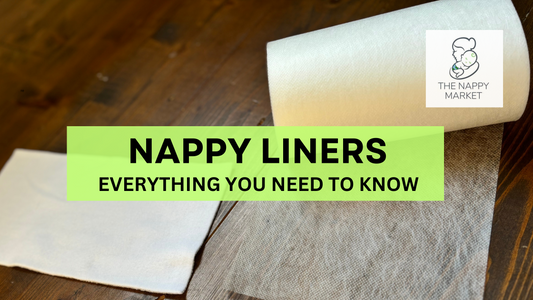First things first - the term "liner" refers to the very top layer within a cloth nappy, the part that goes directly against the babies skin. This is NOT an absorbent part, it will not soak up any moisture. The purpose of a nappy liner is to line the nappy and create a barrier between the baby's bottom and the cloth diaper.
You will come across the term liner being used in reference to the absorbent inserts which can cause confusion - “I used two liners in the nappy”, “the nappy came with two liners” - unfortunately this just adds to the confusion. The absorbent parts are called inserts, these soak up the pee and go inside the nappy. The liner goes between the baby’s bum and the nappy itself or the inserts.

Nappy liners serve a number of purposes:
1. They are a stay dry top layer so the baby doesn't feel any wetness from the cloth diaper.
2. They act as a barrier for rash cream - if using nappy cream on the babys bum, any excess will smear on the liner and not soak into the cloth diaper. (Nappy cream soaking into the diaper can be difficult to remove and can cause a build up which will act as a barrier to absorbency).
3. Poop catcher - liners are primarily for catching solids and making them easier to remove from the cloth diaper before washing.
Types of nappy liners?
Nappy liners come in two forms - disposable version which you put in the bin and a reusable version which you wash and reuse again.
Disposable Nappy Liners - you will find a number of different materials such as cellulose or bamboo. You can use these more than once in the same day if there has not been a soiled nappy. Despite what it might say on the packaging these should always be discarded into the waste bin and not flushed in the toilet system. The waste sewage system is not suitably designed to breakdown these and flushing multiple liners daily could easily result in a blockage or damage to your waste system.
Disposable nappy liners can seem huge, they are often bigger than the actual cloth nappy - this allows for “full coverage” to catch all poop. Avoid folding them in half or cutting them, instead, leave them fully open and then tuck in any parts that are poking out after the nappy is closed on the baby - this allows for the best performance.
Reusable / Washable Fleece Liners - these are a very low cost, extremely useful item in your cloth nappy stash. They are almost dry when they come out of the washing machine. These can be washed and reused over and over again - just like your nappies.
Fleece liners come in fluffy fleece or smooth fleece, they can be rectangular or shaped and come in lots of different patterns or colours.
When do you need to start using them?
Anytime you use diaper cream on your baby you should always use a nappy liner. Reusable liners create a stay dry layer against the babies skin and help lower the occurrence of nappy rash. Using a reusable fleece nappy liner every nappy change is a good habit to get into and is a lower cost option than a disposable liner.
Disposable nappy liners really only need to be used when poo needs to be removed to the toilet, so this happened when your baby begins weaning. Generally at approximately 6 months although weaning can often start earlier. You can use a disposable liner on top of a reusable fleece liner.

As a guide we would suggest using a fleece liner every day change whenever you use a cloth nappy no matter what age your baby is. And then add in the use of a disposable liner when your baby starts weaning.
You will find a selection of disposable and reusable liners here.




